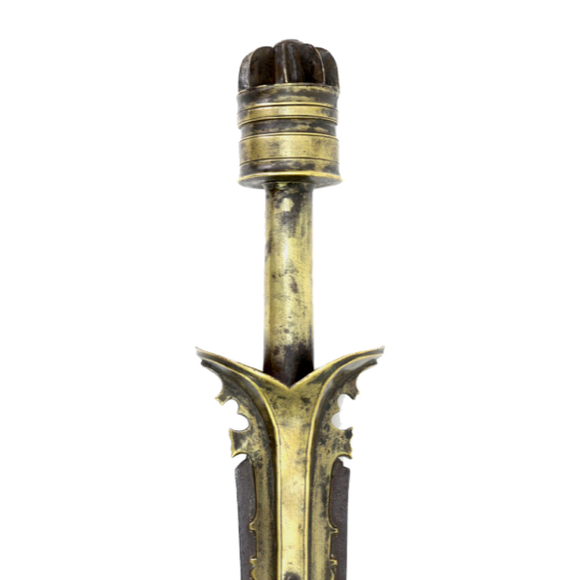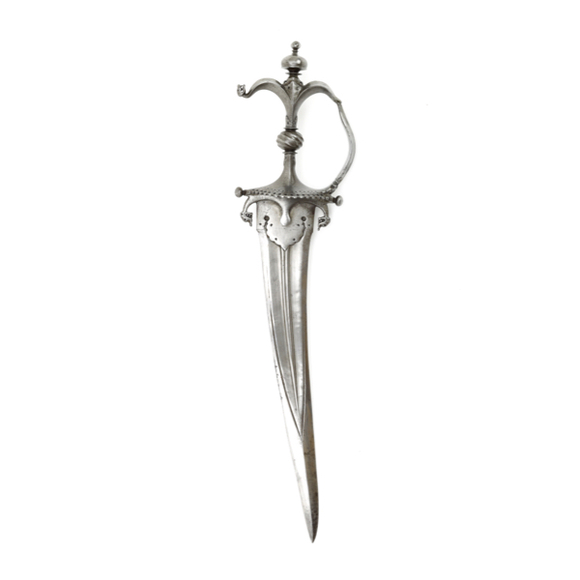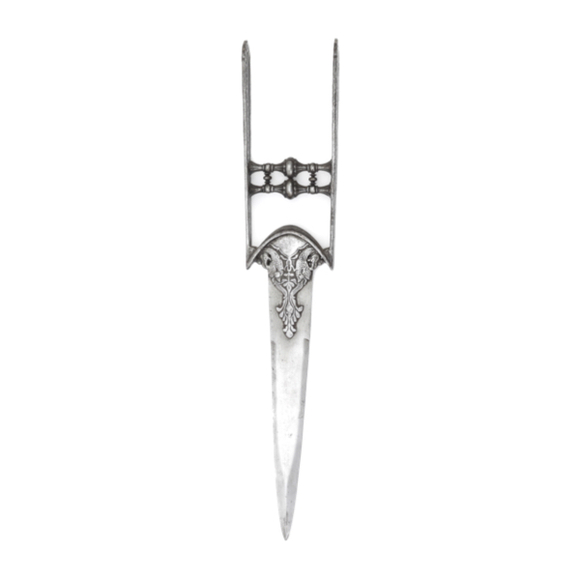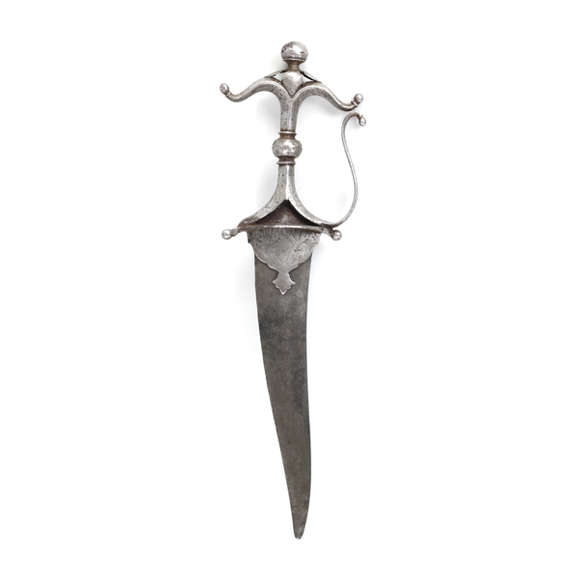An early fighting piece with strong reinforcing langet and broad, cobra shaped tip.

24.8 cm
9.4 cm
13.5 cm (from tip to center-base)
At collar: 4.5 mm
Ahead of collar: 3 mm
Middle: 3 mm
Start of tip: 3 mm
Base: 26 mm (ahead of collar)
Middle: 19 mm
Start of tip: 13 mm
167 grams
South India
1650 - 1700
Introduction
The daggers we now know as khanjarli are characterized by their recurved blade and large lunette pommels that are usually made of ivory plates. They seem to be a further development of the earlier chilanum, some of which have smaller pommels of similar shape. Khanjarli were probably primarily worn as status symbols for the wealthy, as they all tend to be of pretty good to superb workmanship. Most seem to date from the 17th and 18th centuries.
For more information about the type, see the glossary article: Khanjarli
This example
A fine and early example, of classic form. Its characteristic hilt plated with six pieces of ivory riveted to the tang. Most rivets are copper with silver washers, one is silver with a silver washer, probably an old working-life repair.
Two ivory plates form the large lunette pommel that are so typical for the type. The tang was once covered with silver all-around, today there are some losses. A rare feature.
Notable is that this piece lacks the knuckle bow that is almost standard on later examples. This seems to be an early feature, more close to the earlier chilanum from which the design derives.
The blade has another unusual feature: The base of the blade is raised and plated with thick silver. Otherwise it is of typical recurved form. It is forged out of fine wootz, hints of it are visible on the sunken panels in the center of the blade.
Comparable examples
There is a comparable example in the Metropolitan Museum that shares two important features with the dagger presented here: The absence of a knucklebow, and a silver-plated collar piece at the base of the blade.

Left: The subject of this article.
Right: Metropolitan Museum, accession number 36.25.1062a, b
Provenance: W.O. Oldman, G.C. Stone. Bequeathed to the Met in 1935.
Notable examples
A predecessor of this style, in the form of a chilanum with ivory lunette pommel, was also presented to King Edward VII, when Prince of Wales, during this same tour. It was presented by Tukoji Rao Holkar II, Maharaja of Indore. Accession number RCIN 38194. Indore is in the Indian state of Madhya Pradesh, to the West of Orissa and Vizianagram. What these locations have in common is that they were all Maratha territory in the 18th century.
And finally, a very nice example was published by Robert Hales in Islamic and Oriental Arms and Armour: A Lifetime's Passion, Robert Hales C. I. Ltd., Guernsey, UK, 2013. Page 2. This piece came with a little portrait with a note on the back. The note stated: "Portrait of the Maharajah of Vizianagram. Presented with dagger to General A. N. Rich about 1855 for saving his life when attacked by a wounded cheetah.". This is a stunning piece with gold and rubies, undoubtedly reflecting the level of gratitude of the Maharajah.
A red thread among many examples seems to be the Vizianagram connection that Egerton already proposed. (See Glossary; Khanjarli.)
Condition
Overall in very good condition for its age. Some minor play in the pommel plates, the rest is tight.
Conclusion
A fine example of a rarer, earlier form of khanjarli.
CITES
The grip scales are of ivory of the species elephas maximus, listed on CITES appendix I.
The item is within article 2 of council regulation EC NO338/97 and within Convention of International Trade of Endangered Species (CITES): The materials were removed from the wild and significantly altered from their natural state well before the date of convention: June 1st, 1947. In principle, it can be freely traded within the EU.
Beware that it may not be possible to export the item to your country due to restrictions on international ivory trade. CITES sets the minimal restrictions, countries and states under the convention often maintain further restrictions on top of CITES.














Of a style often associated with Tanjore, the seat of the Vijayanagara empire.
Somewhat worn but once very high-quality, with great sculptural qualities and remains of silver "true…






